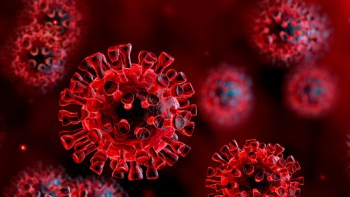
A simple yet potentially very useful model of how living cells interact to create tissue has been created by Anatolij Gelimson and Ramin Golestanian of the University of Oxford in the UK. The simulation considers how individual cells in a colony are simultaneously drawn together by chemical signalling and driven apart by cell division and death. The research suggests that below a certain rate of division and death, the colony tends towards a compact and tissue-like steady state. Above this optimum rate, however, the cells spread increasingly far apart. Although the researchers stress that the model is highly schematic, they hope it could one day provide insights into what causes cancer cells to spread around the body.
As they grow, living cells communicate with each other by excreting chemicals that attract or repel neighbouring cells – a process called chemotaxis. While some bacteria and other single-celled organisms can respond to these chemicals by swimming, the cells that make up the tissues in our bodies move by complex mechanisms that are not well understood. The rate at which the cells move depends on the concentration of the chemical signal in the surrounding environment. Cell movement is also affected by the local density of cells, with cells moving from regions containing lots of cells – such as the bulk of a tissue – to regions with fewer cells, such as the surface of a tissue. This means that the faster the cells divide and die, the faster the cells will expand outwards from the surface of the tissue.
Opposing attraction
Gelimson and Golestanian set out to understand how these two phenomena work together to control the density of tissue. They considered cases in which chemotaxis is attractive – that is, it draws cells together. In this scenario, the amount of chemical attractant increases as the density of cells increases, and this encourages cells to stick together. This also counteracts the tendency of cell division and death to push the cells apart. By calculating the equation of motion for a particular cell, the researchers found that when the rate of cell division and death is below a certain threshold value, these opposing tendencies keep each other in check, and the density of the tissue remains constant as the tissue grows. This is analogous to the situation seen in healthy organs, the researchers suggest, and also in benign tumours.
Above a specific rate of cell division and death, however, the cells move away from each other so rapidly that chemotaxis cannot draw the colony back together. In this regime, the area occupied by the tissue diverges, causing the cells to spread all over the body. The researchers suggest that this discrete cut-off between a stable tissue and the cells spreading apart might provide insight into how a previously benign tumour can suddenly become metastatic and spread throughout the body.
Unexpected competition
The nature of the interplay between density and chemotaxis surprised Gelimson and Golestanian. “Population density is a local effect, whereas chemotaxis is non-local – cells send and receive these signals as chemicals that will travel all the way across the system,” says Golestanian. “But in our equations they appeared in very similar ways and thus they could actually compete with each other, which was not something we expected.”
The biophysicist Herbert Levine of Rice University in the US told physicsworld.com that “There is a new idea here, and there is a methodology to try to figure out what that new idea might lead to.” However, he adds that “The open issue is: is there really a match between these assumptions and some actual experimental realization right now? That’s less clear to me.” In particular, he is sceptical about any direct connection with cancer, as he says cancer cells often stick to each other because of interactions between their protein coats, and the cancers where cells stick to each other are often more likely to spread effectively because they survive transport through the bloodstream better. “To me, that’s an important part of the problem, and I think the work needs to be extended in that direction,” he concludes.
The research is published in Physical Review Letters.



